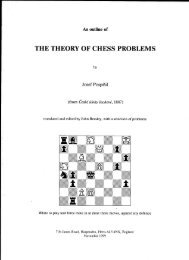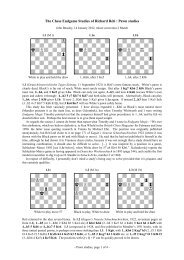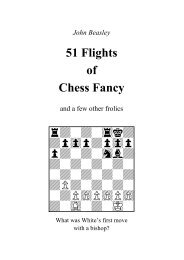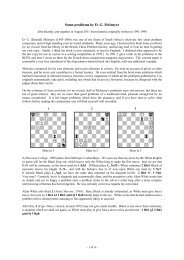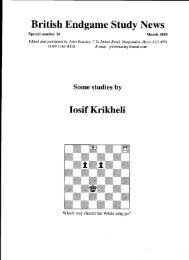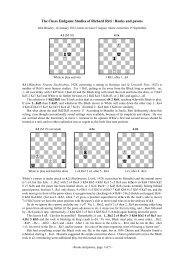A tribute to G. W. Chandler - John and Sue Beasley
A tribute to G. W. Chandler - John and Sue Beasley
A tribute to G. W. Chandler - John and Sue Beasley
Create successful ePaper yourself
Turn your PDF publications into a flip-book with our unique Google optimized e-Paper software.
Three-movers 19<br />
25 (Natal Mercury, 22 February 1919). This was the first of <strong>Ch<strong>and</strong>ler</strong>’s<br />
model-mate half-pin three-movers. The key 1 Ne3 threatening 2 Nf7 is hardly in<br />
the first rank, but then we have the pleasant <strong>and</strong> completely natural thematic lines<br />
1...Na4/Nb3/Nd3/Ne6 2 Ne6+ (2 Nf7? N+) Ke5 3 Nc4 <strong>and</strong> 1...d4 2 Ng2+ Ke5<br />
3 Qe6. There is a third model mate in the line 1...Nxb5 2 Ng2+ Ke5 3 Nxc6.<br />
If 1...Ke5 then 2 Nf7+.<br />
26 (Tidskrift för Schack, 1919). Again the key is mundane, 1 f4 threatening<br />
2 Bg8+ Kf5 3 Qg5, but the thematic half-pin lines are of high quality: 1...Nxf4<br />
2 Bg8+ Kf5 3 e4 <strong>and</strong> 1...Rh5 (a lovely defence, covering the threatened mating<br />
square g5 from the far side) 2 Bg8+ Kf5 3 Qf8. If 1...Qxd2 then 2 Rxd5 with<br />
a third model mate in the line 2...Rxd5 3 cxd5, <strong>and</strong> if 1...Rf5 then 2 Ne4 etc.<br />
There are not many half-pin three-movers with model mates, <strong>and</strong> these of<br />
<strong>Ch<strong>and</strong>ler</strong>’s are worthy additions <strong>to</strong> the s<strong>to</strong>ck. Be it noted that in each of them<br />
(including the one I give in notation in my introduction) the Black king starts off<br />
the pin-line, an embellishment not possible in a two-move setting.<br />
27 (The Observer, 18 July 1954). As we have seen, <strong>Ch<strong>and</strong>ler</strong> often favoured<br />
a newspaper with a later <strong>and</strong> improved version of a problem which had received a<br />
<strong>to</strong>urney award, <strong>and</strong> this was a development of a problem which had received an<br />
honourable mention in a BCF <strong>to</strong>urney. The key 1 Qh5 threatens 2 Qe8+ Kd5<br />
3 Nxe3, <strong>and</strong> the main lines are 1 Nf6/Bd4 2 N(x)d4+ Kd5 3 Be6 with a pin-model<br />
mate, 1...Kb5 2 Qe2+ Kc6 3 Nb4, <strong>and</strong> 1...Nxh3 2 Nb4+ Kd7 3 Nc5. If 1...Kd5<br />
then 2 Nxe3+ etc.<br />
28 (The Problemist, May 1979). This is the first of <strong>Ch<strong>and</strong>ler</strong>’s last three<br />
three-movers. Here, the key 1 Bd8 threatens 2 Qxg7 <strong>and</strong> 3 Qc3/Qd4, <strong>and</strong> the<br />
reason that the bishop has <strong>to</strong> bury itself on d8 is <strong>to</strong> create the star line 1...Na7/Ne7<br />
2 Qxd6+ cxd6 3 Ba5. Other lines are 1...g5/g6 2 Bf6 <strong>and</strong> 1...N(h6)-- 2 Qg4.<br />
“We need a new word for keys like this, which are brilliant but obvious because of<br />
their brilliance,” wrote a solver.<br />
29 (Commended, The Problemist, July 1979). The key 1 Rxh2 threatens<br />
2 Qg2+ hxg2 3 Rh6, <strong>and</strong> the natural reply 1...gxh2 diverts the pawn (shades of 17<br />
once more!) <strong>and</strong> permits 2 Qxa1 (threat 3 Qa6/Qa8) Na3 3 Qh1. Other lines are<br />
1...Nc2 2 Qxb3 <strong>and</strong> 1...Nd2 2 Qxa1. The combination in the main-play of line<br />
clearance, sacrifice, diversion of a Black pawn, <strong>and</strong> ambush is most unusual;<br />
“a brilliant stroke by the old man <strong>to</strong> finish his innings,” wrote Norman Macleod,<br />
perceptively if slightly prematurely. The capture key is a distinct pity, but appears<br />
necessary <strong>to</strong> prevent a cook by 1 Qxb1 <strong>and</strong> 2 Qxa1.<br />
30 (The Problemist, January 1980). This was indeed the finish, <strong>and</strong> it<br />
involved a riot of sacrifices. The key 1 Rf6 threatens the first (2 Qh5+ gxh5<br />
3 Rf5), <strong>and</strong> others appear in the lines 1...Nc4 (tying the rook <strong>to</strong> the defence of c6)<br />
2 Qxd4+ Kxd4 3 Rd3 (exploiting the self-block on c4) <strong>and</strong> 1...Bb1 2 Qb3+.<br />
There remains the second move <strong>to</strong> c4, 1...Bc4, <strong>and</strong> now subtlety replaces violence:<br />
the reply is the quiet 2 Qg4, threatening 3 Qg5 <strong>and</strong> exploiting the fact that 2...Nc4<br />
is no longer possible. Right <strong>to</strong> the end, <strong>Ch<strong>and</strong>ler</strong> unders<strong>to</strong>od the art of pleasing<br />
solvers.



